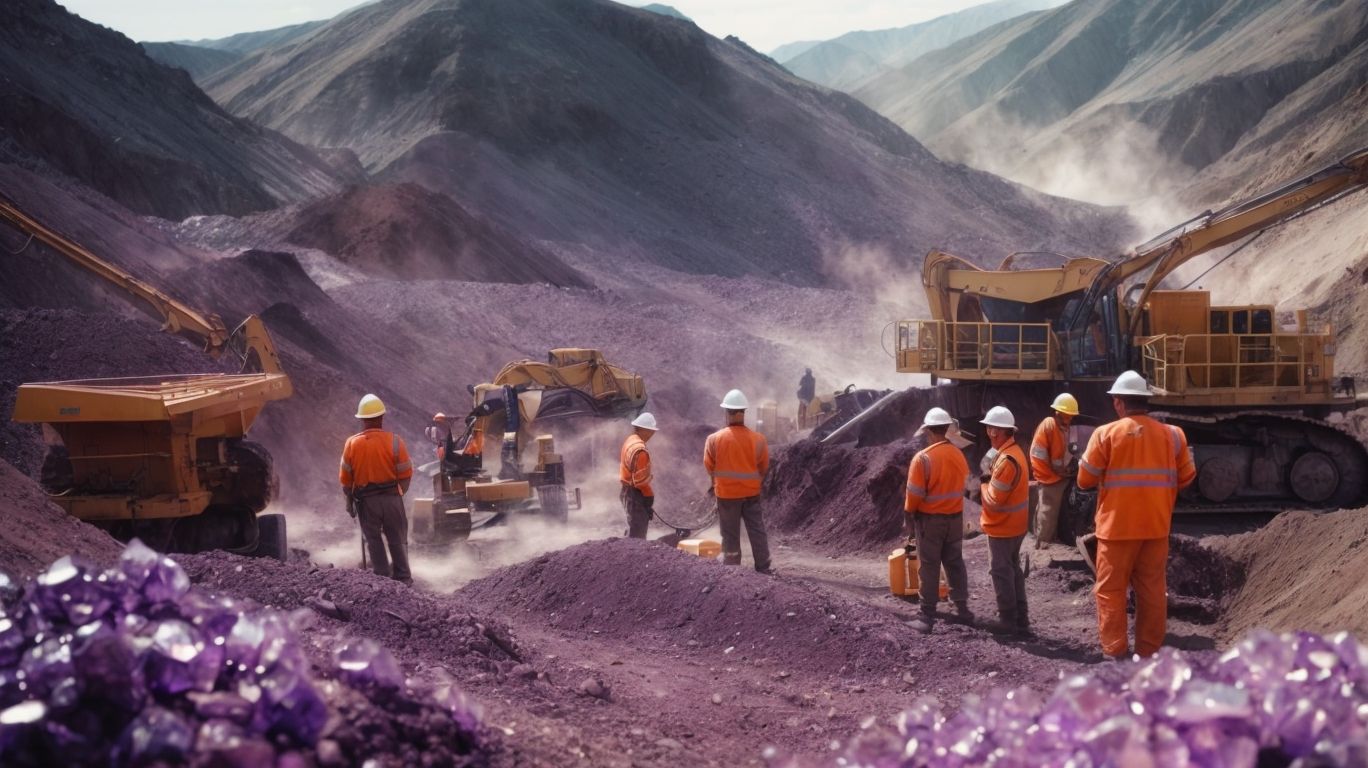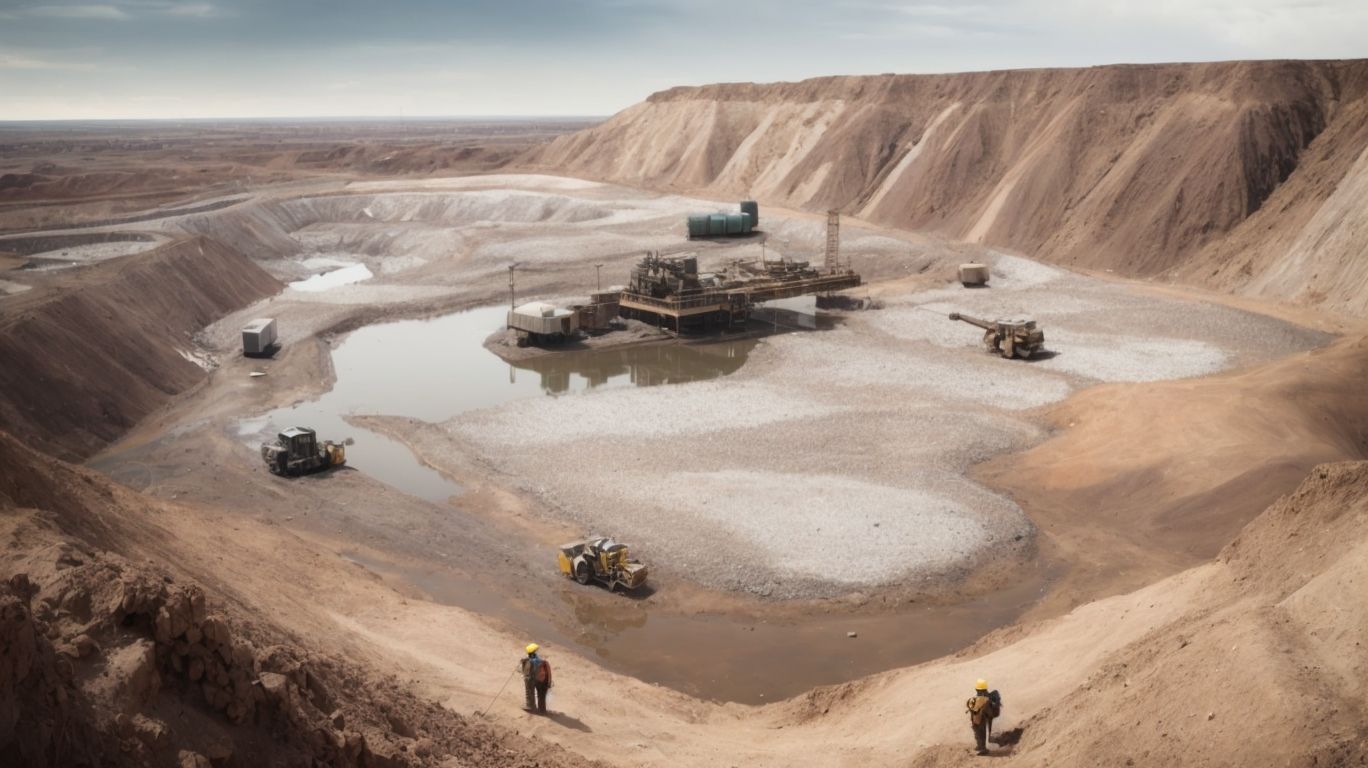
Safety and Environmental Hazards in Amethyst Mining
Amethyst mining is a fascinating process that involves extracting this beautiful gemstone from the earth. Like any mining activity, it comes with its own set of safety and environmental hazards that need to be addressed.
From physical and chemical hazards to soil erosion and deforestation, the impact of amethyst mining on both workers and the environment can be significant.
In this article, we will explore the different safety hazards in amethyst mining, how they can be prevented, as well as the environmental hazards and ways to mitigate them.
Let’s delve into the world of amethyst mining and learn how we can protect both people and the planet.
What Is Amethyst Mining?
Amethyst mining is the process of extracting the semi-precious gemstone known as amethyst from the earth’s crust for various commercial and industrial purposes.
This mining process involves locating and extracting amethyst deposits from mines or quarries, which are often found in igneous rocks like granite or pegmatites. Amethyst holds significant value in the gemstone industry due to its striking purple color and spiritual and healing properties. Geological occurrences that lead to the formation of amethyst deposits include the presence of iron and aluminum in rock formations, as well as specific temperature and pressure conditions necessary for crystal growth.
How Is Amethyst Mined?
The mining of amethyst involves specialized techniques and equipment to extract the gemstone from mineral deposits efficiently and sustainably.
What Are The Different Methods Of Amethyst Mining?
Amethyst can be mined using different techniques such as open-pit mining, underground mining, and alluvial mining, each method tailored to the geological characteristics of the deposit.
- Open-pit mining is a commonly used method for extracting amethyst near the surface, involving the excavation of large open pits where the gemstones are easily accessible. This technique is relatively cost-effective and allows for the use of heavy machinery to extract the amethyst efficiently.
- On the other hand, underground mining involves creating tunnels and shafts to access deeper amethyst deposits, posing potential safety hazards and requiring specialized equipment.
- Alluvial mining, which involves searching for amethyst in riverbeds and sediment deposits, can be challenging due to the need for constant sorting and screening of materials to find the gemstones.
What Are The Safety Hazards In Amethyst Mining?
Amethyst mining poses various safety hazards to workers and the environment, including risks related to occupational health, geological conditions, and compliance with safety regulations.
Physical Hazards
Physical hazards in amethyst mining include risks such as cave-ins, rockfalls, and unstable ground conditions, emphasizing the need for effective hazard control measures and safety guidelines.
Occupational safety in amethyst mining operations plays a crucial role in protecting workers from potential dangers. Geological risks, such as underground collapses and unstable mine walls, pose inherent threats that require constant vigilance. Hazard control strategies typically involve comprehensive risk assessments, regular inspections, and implementation of safety protocols. Safety guidelines emphasize the importance of proper training, use of personal protective equipment, and adherence to established safety procedures to minimize the chances of accidents and injuries in the mining environment.
Chemical Hazards
Chemical hazards in amethyst mining involve exposure to toxic substances and hazardous materials, requiring stringent environmental protection measures and safety protocols to prevent health risks.
These toxic substances are commonly found during the mining process, such as sulfuric acid, mercury, and asbestos. These chemicals can pose serious health risks to miners, including respiratory problems, skin irritations, and even long-term health issues.
In order to protect both the environment and the workers, mining companies have implemented various safety measures, including providing proper protective gear, ensuring proper ventilation systems, and conducting regular training on handling hazardous materials.
Efforts are being made to minimize the use of these toxic chemicals and explore alternative methods to reduce their impact on both human health and the surrounding ecosystem.
Ergonomic Hazards
Ergonomic hazards in amethyst mining can result from poor work practices and non-compliance with safety regulations, underscoring the importance of promoting occupational safety and adherence to safe work practices.
Workers in such mining operations often face risks related to repetitive motions, awkward postures, and heavy lifting, all of which can lead to musculoskeletal disorders. It is crucial for companies to prioritize ergonomics to prevent long-term health issues among their employees. By implementing proper training programs, providing ergonomic equipment, and ensuring that safety protocols are strictly followed, organizations can significantly reduce the incidence of workplace injuries and safeguard the well-being of their workforce.
Biological Hazards
Biological hazards in amethyst mining may include exposure to pathogens and contaminants that pose health risks to workers, necessitating health risk assessments and regular safety audits to maintain workplace health standards.
These hazards stem from various sources such as dust containing silica, heavy metals, and potential chemical spills, all of which can lead to respiratory issues, skin irritations, and other health complications for individuals working in the mines.
Experts emphasize the importance of conducting thorough health risk assessments to identify potential exposures and implement appropriate control measures. Safety audits play a crucial role in identifying gaps in safety protocols and ensuring that workers are adequately protected from these biological hazards.
How Can These Safety Hazards Be Prevented?
Preventing safety hazards in amethyst mining requires a comprehensive approach that includes risk assessments, workplace safety protocols, and regular safety training for workers.
Proper Training And Education
Proper training and education programs are essential in amethyst mining to cultivate a strong safety culture and ensure effective safety supervision across mining operations.
By investing in continuous training and education for mining personnel, companies can empower their workforce to recognize potential hazards, use safety equipment correctly, and respond appropriately in case of emergencies. This proactive approach not only enhances the overall safety of the mine but also boosts employee morale and reduces the likelihood of accidents.
Safety supervision plays a crucial role in overseeing that safety protocols are being followed diligently, conducting regular inspections, and providing immediate guidance to address safety concerns. Building a safety-conscious culture through training and supervision is a long-term investment in the well-being of both the workers and the operation itself.
Use Of Personal Protective Equipment (PPE)
The use of personal protective equipment (PPE) is crucial in amethyst mining to safeguard workers from potential hazards and ensure compliance with safety measures.
Effective PPE in amethyst mining includes items like hard hats to protect from falling rocks or debris, safety goggles to shield eyes from dust and particles, and sturdy gloves to prevent cuts and abrasions.
By wearing the appropriate gear, miners can significantly reduce the risk of injuries and long-term health issues. PPE also plays a key role in meeting regulatory standards and maintaining a safe working environment.
Investing in proper training on PPE usage can further enhance safety protocols and ensure all workers are well-equipped for the demands of amethyst mining operations.
Regular Maintenance And Inspection Of Equipment
Regular maintenance and inspection of mining equipment play a vital role in preventing accidents and ensuring operational safety standards are met in amethyst mining operations.
Conducting routine maintenance and equipment inspections in amethyst mines is crucial for safeguarding the well-being of miners and maintaining the efficiency of operations. Safety audits and inspections help in identifying potential hazards that could compromise the safety of workers and the integrity of the mining site. Regular equipment inspections contribute to ensuring that all machinery is in optimal working condition, thereby enhancing productivity and minimizing downtime in the mining process.
By prioritizing maintenance practices and inspections, amethyst mining operations can uphold high safety standards and sustain equipment reliability for long-term success.
Implementation Of Safety Protocols And Procedures
The implementation of robust safety protocols and procedures is essential in amethyst mining to promote safety compliance, mitigate risks, and adhere to safety regulations.
Establishing clear safety protocols and procedures not only ensures the well-being of miners but also plays a crucial role in maintaining a safe working environment. By adhering to safety regulations and following best practices, mining companies can minimize potential hazards and prevent accidents. These protocols help to identify and address potential risks in advance, leading to a safer and more efficient mining operation. Prioritizing safety in amethyst mining sites is paramount to safeguarding the health and lives of workers and preserving the integrity of the mining site.
What Are The Environmental Hazards In Amethyst Mining?
Amethyst mining operations can pose significant environmental hazards such as soil erosion, water pollution, air pollution, and deforestation, impacting ecosystems and natural habitats.
Soil Erosion And Land Degradation
Soil erosion and land degradation are common environmental hazards in amethyst mining, necessitating effective land reclamation and rehabilitation practices to restore ecosystems and promote environmental conservation.
The unregulated excavation and earth-moving activities in amethyst mining can disrupt natural landscapes, leading to soil erosion and loss of biodiversity. Without proper intervention, degraded lands can become barren, impacting the livelihoods of local communities and threatening the surrounding ecosystem. In response, initiatives focused on reclamation and rehabilitation have been instrumental in reversing the damage caused by mining operations. By implementing sustainable practices and conservation efforts, it is possible to strike a balance between economic development and environmental preservation.
Water Pollution
Water pollution arising from amethyst mining activities can have detrimental effects on aquatic ecosystems, underscoring the need for proper waste disposal methods and environmental protection measures.
Improper waste disposal practices in amethyst mining, such as tailings and toxic chemical runoff, can contaminate nearby water sources, leading to disruptions in the delicate balance of aquatic life.
To combat this, implementing effective waste management techniques like sedimentation ponds, chemical neutralization, and water treatment systems is crucial.
Proactive water protection strategies, such as establishing buffer zones around water bodies, regular monitoring of water quality, and strict enforcement of environmental regulations, play a pivotal role in safeguarding aquatic habitats.
Environmental preservation efforts are vital in mitigating water pollution risks, emphasizing the interconnectedness between human activities and the health of our ecosystems.
Air Pollution
Air pollution resulting from dust emissions and vehicle exhaust in amethyst mining operations can impact air quality and contribute to noise pollution, necessitating effective environmental management strategies.
Efforts to mitigate these environmental risks include implementing dust control measures, such as watering unpaved roads and using enclosed conveyors to minimize dust release. Reducing the reliance on fossil fuel-powered vehicles and incorporating electric or hybrid options can help lower emissions. Proper monitoring and regular maintenance of equipment also play a crucial role in controlling air pollution. By incorporating sound environmental management practices, the mining industry can significantly reduce its environmental footprint and ensure sustainable operations.
Deforestation
Deforestation is a critical environmental hazard linked to amethyst mining activities, posing threats to biodiversity, ecological balance, and long-term environmental sustainability.
The removal of trees for mining not only disrupts the natural habitat but also contributes to soil erosion, loss of vegetation cover, and reduced water quality in surrounding areas. This, in turn, affects the wildlife that depends on the forest ecosystem for food and shelter.
Deforestation leads to a decline in carbon sequestration, exacerbating climate change. To address these challenges, it is imperative for the mining industry to embrace sustainable practices that prioritize ecosystem restoration, responsible land management, and reforestation efforts.
How Can These Environmental Hazards Be Mitigated?
Mitigating environmental hazards in amethyst mining requires the adoption of sustainable practices, environmental remediation efforts, and compliance with environmental regulations to minimize ecological impacts.
Proper Waste Management
Implementing proper waste management protocols is crucial in amethyst mining to handle hazardous waste materials responsibly and ensure safe waste disposal practices to minimize environmental risks.
Responsible waste management practices play a vital role in protecting the ecosystem surrounding mining areas. By implementing specific procedures for hazardous waste handling, such as segregating different types of waste and utilizing proper containment methods, miners can significantly reduce the potential negative impacts on air, water, and soil quality.
Employing efficient waste disposal methods, such as recycling where possible and utilizing authorized waste disposal facilities, helps in preventing pollution and preserving the natural environment. Prioritizing effective waste management ensures sustainable mining practices and a healthier environment for future generations.
Use Of Sustainable Mining Practices
Adopting sustainable mining practices in amethyst mining operations is essential to promote environmental sustainability, conserve natural resources, and reduce the ecological footprint of mining activities.
- By implementing strategies such as reducing water usage,
- reusing materials,
- and restoring mined areas, miners can minimize the impact on the surrounding ecosystem.
Utilizing renewable energy sources and technologies like drone mapping and automation can also help in making the mining process more efficient and environmentally friendly. Engaging with local communities and indigenous peoples to ensure their involvement and benefit from mining activities plays a crucial role in fostering long-term ecological balance and social sustainability.
Reclamation And Rehabilitation Of Mined Areas
Reclaiming and rehabilitating mined areas in amethyst mining sites is crucial to restore ecosystems, monitor environmental impacts, and promote land rehabilitation for sustainable land use.
- Efforts in reclamation and rehabilitation not only aim to repair the damage caused by mining activities but also serve as a proactive measure to ensure long-term environmental health. Land restoration techniques such as regrading, re-vegetation, and soil stabilization are commonly used to restore the area’s natural habitat and prevent erosion.
- Environmental monitoring practices play a key role in tracking the progress of rehabilitation efforts, assessing water quality, air quality, and soil health. Post-mining land rehabilitation initiatives help to transform once disturbed landscapes into productive and ecologically diverse areas, benefiting both the environment and local communities.
Collaboration With Local Communities And Environmental Organizations
Collaborating with local communities and environmental organizations in amethyst mining projects is vital to foster environmental stewardship, address community health concerns, and promote sustainable mining practices.
By involving local stakeholders in the decision-making processes, mining companies can gain valuable insights into the specific environmental and social challenges faced by the community. This collaboration not only enhances transparency and accountability but also helps in developing tailored solutions that benefit both the environment and the people living in the vicinity of the mining sites. Engaging with environmental groups can lead to the implementation of best practices in land reclamation, water management, and wildlife conservation, ensuring a more responsible and sustainable approach to mining operations.




No Comments